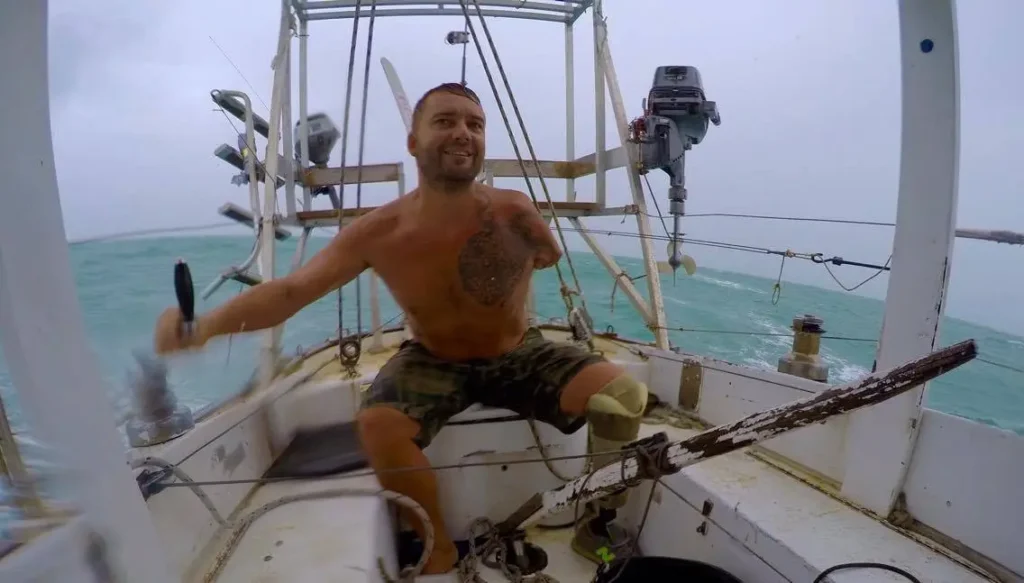
Listen to this Article
On October 18, 2008, a drunk driver struck Dustin Reynolds’ motorcycle on a Hawaii roadside. He lost his left arm, left leg, nearly his life, and later his businesses. Each year he marks that date not with mourning, but gratitude. “I celebrate because I made a choice to live on that day,” he says. Years later, that choice carried him around the world: in 2021 he completed a solo circumnavigation, the first double amputee to do so.
Reynolds was no lifelong sailor. Aside from a single lake outing with his father, boats were foreign to him. As an adult he taught himself from books and videos, learning one term at a time . . . “reef the sails” moving from mystery to instinct. He bought a modest boat in Hawaii, cruised the islands with his roommate, then set off solo across the Pacific, adapting his vessel for one-handed use.
The sea tested him early. Near Fanning Island, his windvane rudder broke; he carved a replacement from a wooden oar. Days later, a gale split a hull seam and water poured in. He stuffed the gap with T-shirts and plastic bags, limping to Samoa for repairs. That blend of improvisation and stubborn calm became his hallmark. He modified his prosthetics the same way, replacing finicky parts with motorcycle inner tubes and carrying a second leg for diving that doubled as a source of spare parts.
His voyage stretched over seven and a half years, five oceans, and 36 countries. He lingered where others passed quickly, staying long enough to share meals, learn routines, and build friendships. In Vanuatu, he ate with a chief’s family, joined spearfishing trips, and screened a film for village children on his 35-foot deck, only to learn the violent images gave them nightmares. He filed away that lesson: different places, different reference points.
What he remembers most are people. In Africa and Southeast Asia, strangers often approached directly, asking about his injuries. In Europe and North America, many pretended not to notice. He didn’t mind either response; he jokes with kids who stare, answers questions when they come, and accepts curiosity as part of connection.
The final year proved hardest. COVID closures thinned the dockside community, leaving anchorages full of boats but short on camaraderie. The great capes were already behind him, and the journey’s end felt like running out the clock. Yet Hawaii gave him a hero’s welcome: friends, strangers, and crowdfunders lined the harbour to cheer him home.
Today Reynolds captains a 65-foot yacht, gives talks, and guides divers among hammerheads and Galápagos sharks. He teaches nervous beginners that a taxi is statistically riskier than a shark dive. Fear swells in the imagination, he says; facts trim it back to size.
For travellers with mobility challenges, his advice echoes seamanship: keep systems simple, choose gear you can fix, build redundancy, and plan for the elements. Accept help when it helps; decline it when it risks your balance. Above all, make steady decisions: eat, rest, repair early. Confidence grows not from one grand gesture, but from a hundred small completions.
Each Oct. 18 he pauses, not to glorify the wreck, but to honour the choice he made: to continue. That choice carried him through storms, quiet midwatches, and customs lines, until he had written his wake across the world.
Single handed, yes. Singular, yes. A sailor who proved determination can be engineered, rehearsed, and lived, one decision at a time.
Follow Dustin Reynolds
Snapshots from Dustin Reynolds’ solo sail around the world
Hawaii (starting and ending point)
- Home, launchpad and finish line
- Community support through crowdfunding kept his voyage afloat
- Warm return with friends and family waiting on the dock
Palmyra Atoll
- First long crossing went smoothly
- Introduced him to the rhythm of offshore sailing
Fanning Island (Kiribati)
- Faced bureaucratic hurdles and a $500 fine he couldn’t pay
- Forced to leave but marked an early test of resourcefulness
American Samoa
- Arrival after storms and a near-sinking hull
- Repaired his boat with fiberglass over T-shirts and plastic bags still stuffed in the seam
Tonga
- Welcoming stop after hard ocean miles
- Gained confidence continuing westward
Fiji
- Another key waypoint where he paused and adjusted before pressing on
Vanuatu
- Deepest cultural immersion
- Lived in villages, ate nightly with a chief’s family, went spearfishing, hosted a movie night for children on his boat
- Witnessed how tightly communities value each member and how emotional departures could be
Madagascar
- Ranked among his favourites
- Stunning biodiversity and landscapes
- Struck by the beauty of the people as well as the place
Chagos Archipelago
- Remote and pristine, defined by its wild, natural environment
Galápagos Islands
- Abundance of unique wildlife left a strong impression
Cocos Island (Costa Rica)
- Dive master for new divers
- Saw hammerhead, Galápagos and silky sharks in huge numbers
- Used it as an example to teach fear vs. reality
Andaman Islands
- Noted for extraordinary nature and culture
- A highlight of his wildlife-rich destinations
South Africa
- Memorable encounters with other amputees and conversations around identity
- A place where candid conversations shaped his view of disability and perception
Grenada (and Carriacou)
- Spent several months there, even hauled out his boat for maintenance
- Enjoyed Hog Island cookouts and Sunday gatherings
- Called it safe and easy-going, with welcoming locals
St. Vincent, Grenadines and St. Lucia
- Part of his Caribbean route
- Enjoyed the islands’ vibrancy, though the Caribbean overall felt more tourist-heavy and less connected compared to earlier anchorages
Dominica
- His favourite Caribbean island
- Loved the natural beauty and atmosphere
St. Helena and Ascension Islands
- Atlantic crossings that linked his route back toward the Caribbean and final legs
Dustin Reynolds’ guidance for travellers with mobility challenges
Keep systems simple
Reynolds learned quickly that complexity breaks down in salt, sand, and time. He stripped valves from his prosthetics and replaced them with a motorcycle inner tube that could be patched anywhere. His advice:
- Choose gear that is rugged, not fancy.
- The more moving parts, the more that can fail.
- Build habits around efficiency—fewer steps, fewer points of failure.
Design for repair, not replacement
A cruising boat taught him that when something fails offshore, the only mechanic is you. He urges mobility-challenged travellers to apply the same principle:
- Select equipment you can fix with basic tools.
- Carry small spares but make them interchangeable across multiple uses.
- A single bolt that fits both a walking leg and a diving prosthetic is more valuable than ten specialized parts.
Adapt, don’t avoid
For Reynolds, refusing adventure was never an option. Instead, he focused on adapting:
- Reorganize your environment to suit your body. (On his boat, every critical line could be reached with one hand.)
- Modify equipment unapologetically. Comfort and function come before aesthetics.
- Treat adaptation as creativity, not compromise.
Accept help when it helps
Reynolds found that strangers are often eager to help, though in very different ways depending on culture. His counsel:
- Let people carry a bag, open a door, or steady you when it saves energy for what really matters.
- Say no firmly when “help” risks your safety or throws you off balance.
- See help as partnership, not pity.
Plan for the elements
Travel means exposure . . . to weather, to terrain, to the unexpected. His experience suggests:
- Assume you’ll face rain, mud, sand, and stairs.
- Protect gear from water and grit, even if it means a low-tech solution like plastic bags and tape.
- Carry backups for essentials that would leave you stranded if they failed.
Separate fear from risk
Reynolds often tells divers that taxis statistically pose more danger than sharks. The same logic applies to travel:
- Don’t let imagined fears shrink your world.
- Research the true risks, then prepare accordingly.
- Confidence grows from small, repeated steps outside your comfort zone.
Make decisions early and often
For him, survival and success came down to choosing . . . over and over:
- Decide to go, even if imperfectly prepared.
- Decide to fix a problem when it’s small, before it grows.
- Decide to laugh when a repair looks ridiculous but works.
- Above all, decide to continue. Each choice compounds into resilience.
In Reynolds’ own story, mobility challenges never cancelled possibility. They demanded forethought, improvisation, and courage, but they also sharpened the rewards. His message is simple: build for durability, stay adaptable, accept kindness wisely, and keep moving forward.
